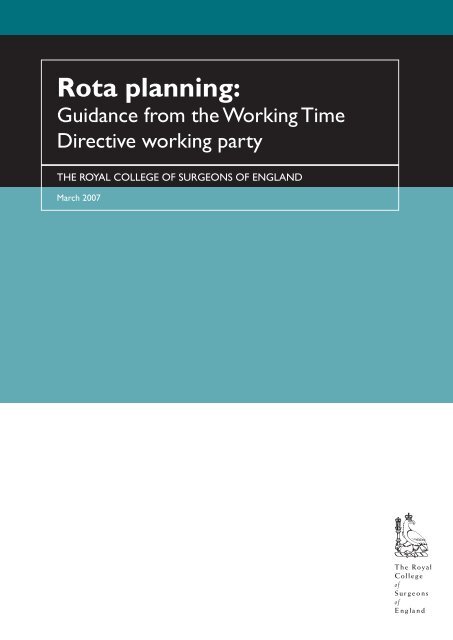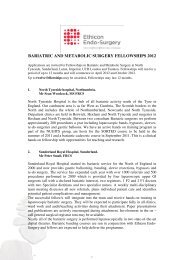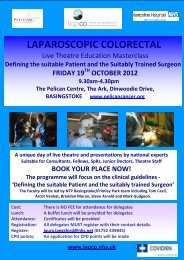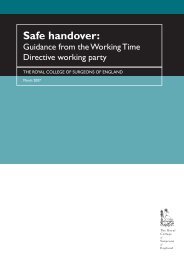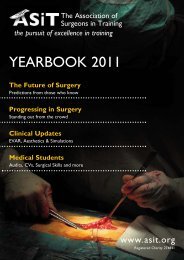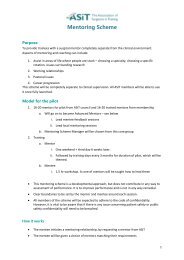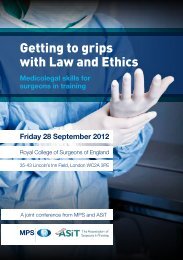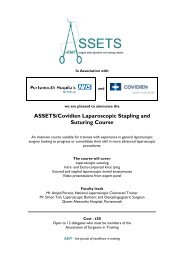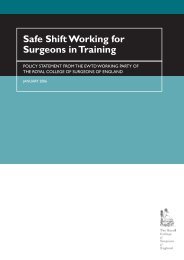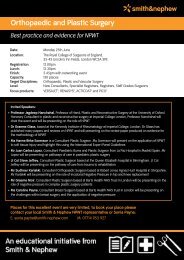rota planning.pdf - The Royal College of Surgeons of England
rota planning.pdf - The Royal College of Surgeons of England
rota planning.pdf - The Royal College of Surgeons of England
- No tags were found...
You also want an ePaper? Increase the reach of your titles
YUMPU automatically turns print PDFs into web optimized ePapers that Google loves.
Rota <strong>planning</strong>:Guidance from the Working TimeDirective working partyTHE ROYAL COLLEGE OF SURGEONS OF ENGLANDMarch 2007
GUIDANCE ON ROTA PLANNING <strong>The</strong> <strong>Royal</strong> <strong>College</strong> <strong>of</strong> <strong>Surgeons</strong> <strong>of</strong> <strong>England</strong>Introduction<strong>The</strong> <strong>College</strong> recognises that in order to implement European Working Time Directive (EWTD) requirements,many units have implemented full-shift working arrangements to meet service need and to simplify <strong>rota</strong><strong>planning</strong>. We are concerned, however, that these arrangements may be detrimental both to training and to thecontinuity and quality <strong>of</strong> care. This paper is intended to provide guidance on safe and efficient <strong>rota</strong> design forthose responsible for <strong>planning</strong> surgical <strong>rota</strong>s.When <strong>planning</strong> <strong>rota</strong>s the following need to be taken into account:>>>delivery <strong>of</strong> service – having enough staff to carry out the required service safely and effectively;continuity <strong>of</strong> service – ensuring that shift changes enable the continuity <strong>of</strong> a patient’s care; andtraining and supervision – ensuring that staff in training grades are receiving appropriate trainingopportunities and receiving the correct level <strong>of</strong> supervision.Types <strong>of</strong> <strong>rota</strong>>>>>On-call: doctors working on-call <strong>rota</strong>s usually work a set working day from Monday to Friday. <strong>The</strong> out<strong>of</strong>-hoursduty period is covered by doctors working on-call in <strong>rota</strong>tion. Juniors may be rostered for dutyperiods <strong>of</strong> more than 24 hours and would be expected, in addition to natural breaks, to achieve rest forat least one half <strong>of</strong> the out-<strong>of</strong>-hours duty period (ie between 8 and 12 hours depending on the period <strong>of</strong>duty, but in all cases, at least five hours). <strong>The</strong> continuous rest should be taken between 10pm and 8am.Partial shifts: on most weekdays doctors on partial shifts work a normal day. But at intervals, one ormore doctors will work a different duty for a fixed period <strong>of</strong> time, eg evening or night shifts. Doctorscan expect to work for a substantial proportion <strong>of</strong> the out-<strong>of</strong>-hours duty period, during which time theywill expect to achieve some rest in addition to natural breaks. Juniors may be rostered for duty periods <strong>of</strong>not more than 16 hours. If the partial shift occurs in the out-<strong>of</strong>-hours period, then one quarter <strong>of</strong> thisperiod should be available for rest (eg between three and four hours depending on the shift pattern).24-hour partial shifts: weekdays are usually worked as normal days. In <strong>rota</strong>tion, a duty period is rostered,not exceeding 24 hours including handovers, for the weekend and out-<strong>of</strong>-hours cover. Juniors will berostered for duty periods <strong>of</strong> more than 16 hours, but no more than 24 hours. <strong>The</strong>y should achieve aminimum <strong>of</strong> six hours’ rest during the period <strong>of</strong> duty, at least four hours <strong>of</strong> which should be continuousrest. <strong>The</strong> continuous rest should be taken between 10pm and 8am.Full shifts: a full shift will divide the total working week into definitive time blocks, with doctors <strong>rota</strong>tingaround the shift pattern. Doctors can expect to be working for the whole duty period, except for naturalbreaks. Juniors will be rostered for duty periods that do not exceed 13 hours. At least 30 minutes’continuous break must be taken after every six hours <strong>of</strong> continuous duty under EWTD requirements orafter every four hours under the New Deal.More guidance on <strong>rota</strong>s and rest breaks is available. 1General principles – <strong>rota</strong> planners will need to:>>>pr<strong>of</strong>ile the activities <strong>of</strong> the hospital within a region-wide context;look at the activities <strong>of</strong> the average day – how many doctors are required? Of which grade? At whattimes?;consult all doctors involved in the <strong>rota</strong>;
<strong>The</strong> <strong>Royal</strong> <strong>College</strong> <strong>of</strong> <strong>Surgeons</strong> <strong>of</strong> <strong>England</strong> GUIDANCE ON ROTA PLANNING >>know the rules <strong>of</strong> both the New Deal and the EWTD; andthink <strong>of</strong> <strong>rota</strong>s in terms <strong>of</strong> service delivery and training opportunities, and map trainees’ work to theirtraining needs.Tiers <strong>of</strong> cover<strong>Surgeons</strong> fall into the following categories:>>Career grades:• consultants;• associate specialists; and• staff/Trust grades (or the proposed ‘specialty doctor’ grade in the future).Trainees:• foundation years 1 and 2 (F1 and F2);• senior house <strong>of</strong>ficers (until August 2007);• specialist registrars (SpRs) or specialist trainees; and• fixed term specialist trainees (after August 2007).Some hospitals have implemented the Hospital at Night system, where a team <strong>of</strong> health care pr<strong>of</strong>essionalsbecome responsible for the care <strong>of</strong> all patients in the hospital during the night. Other hospitals or specialtiesrequire a dedicated team <strong>of</strong> clinicians and nurses to look after patients at all hours, throughout the week. It isfor each hospital to decide the level <strong>of</strong> cover, based on accurate demand pr<strong>of</strong>iling and risk assessment. <strong>The</strong>following guidance is <strong>of</strong>fered to help with this assessment – it is not an exhaustive list:>>>>It may be appropriate to have some members <strong>of</strong> staff working during their full shift, and others availableto give advice and support from elsewhere in the hospital (resident on-call) or a remote location (nonresidenton-call).Remember that time spent residentially on-call by doctors must be regarded in its entirety as workingtime. This makes resident on-call working patterns unworkable in terms <strong>of</strong> the EWTD and New Deal.Some doctors may opt to remain at the hospital while on-call – this is termed ‘voluntarily resident oncall’.This may be because they need to be on-call but live too far away from the hospital or do not wishto disturb their family with telephone calls during the night.Compensatory rest must be given to doctors who are non-resident on-call, but who are called upon towork during the period <strong>of</strong> duty. Rest provided must make up for rest missed, and should take place assoon as possible after the end <strong>of</strong> the working period.Depending on the work involved, trainees can work under the supervision <strong>of</strong> consultant surgeons,associate specialists, or staff/Trust grade surgeons. For early years trainees (F1, F2, ST1 and 2 or currentSHOs) full-shift working can <strong>of</strong>fer valuable training opportunities and these trainees can usefully providecross-cover (providing the cover is within the trainee’s level <strong>of</strong> ability or knowledge and will supportpatient safety). Trainees at this level <strong>of</strong>ten staff Hospital at Night teams.>However, for more experienced trainees (for example, current SpRs or those in ST3+), the <strong>College</strong> 2and the National WTD Stakeholder Group 3 recommend that night shifts be minimised as they donot provide appropriate training opportunities. In addition, cross-cover at this level is not consideredappropriate by the <strong>College</strong> and the surgical specialist associations.
GUIDANCE ON ROTA PLANNING <strong>The</strong> <strong>Royal</strong> <strong>College</strong> <strong>of</strong> <strong>Surgeons</strong> <strong>of</strong> <strong>England</strong>>>Career grade surgeons are not bound by the conditions <strong>of</strong> the New Deal contract. <strong>The</strong>y can individuallychoose to opt out <strong>of</strong> the working hours limits imposed by the EWTD but they cannot opt out <strong>of</strong> theminimum rest requirements (ie 11 hours’ rest in 24). <strong>The</strong> capability for individuals to opt out <strong>of</strong> theEWTD working hours limits provides some flexibility in service <strong>planning</strong>; however, working hours mustbe recognised in surgical consultant contracts. Trusts must also bear in mind that cover provided bycareer grade staff during the evening or at night will impact on their availability the next day.Doctors in training may voluntarily opt out <strong>of</strong> the provisions <strong>of</strong> the directive by signing a waiver statingthat they choose to work in excess <strong>of</strong> the average weekly hours. However, as stated above, no employeecan opt out <strong>of</strong> the rest requirements <strong>of</strong> the EWTD. In practice, contracts <strong>of</strong> employment for doctors intraining state that they should not exceed an average <strong>of</strong> 56 hours <strong>of</strong> work per week. In addition, wherevoluntary opt-out would have an effect on those sharing a <strong>rota</strong>, a collective agreement would be required.Facilities required for full shiftIf unit pr<strong>of</strong>iling suggests that full-shift working is required, the Trust must ensure that adequate rest breaksare provided (after every six hours according to the enactment <strong>of</strong> the EWTD in the UK) and facilities forsuch rest breaks must be appropriate. This should address issues <strong>of</strong> posture and comfort, appropriate lighting,sound dampening, privacy, hygiene and catering.<strong>The</strong> Junior Doctors Committee and the Academy <strong>of</strong> Medical <strong>Royal</strong> <strong>College</strong>s 4 have released a statement thatmakes the following points with regard to rest:>>>>Doctors should not be prevented from sleeping when there is no work for them to do.Doctors should be adequately rested in order to care for their patients effectively.Existing on-call rooms should be retained for use by medical staff on night shifts.Doctors need adequate facilities in which to rest at night, which are away from the ward and separatefrom those used for making tea and c<strong>of</strong>fee.Ideal <strong>rota</strong> configurations for patient and staff safety<strong>The</strong> <strong>College</strong> recommends that:>>>>shifts last for no longer than 13 hours;night shifts last no more than three consecutive nights and are followed by two uninterrupted nights’sleep before returning to daytime working;senior surgical trainees are removed from night shifts in order to consolidate learning and maximisedaytime training opportunities; andwork is brought into the extended day wherever possible to ensure optimum training opportunities, withonly life- or limb-threatening conditions scheduled for emergency operative procedures in the out-<strong>of</strong>hoursperiod.Good practiceRota planners should work with surgical teams to identify where training opportunities are present and takeadvantage <strong>of</strong> them. Work that does not present opportunities for trainees progressing should be undertaken,where possible, by career grade surgeons. It is important to give the surgical team ownership <strong>of</strong> its <strong>rota</strong> sothat clinicians can plan towards them with education in mind and so that consultant surgeons can themselvesidentify where it is more practical for them to provide a service, rather than trainees.
<strong>The</strong> <strong>Royal</strong> <strong>College</strong> <strong>of</strong> <strong>Surgeons</strong> <strong>of</strong> <strong>England</strong> GUIDANCE ON ROTA PLANNING Ensure that sufficient time is provided for a proper handover toward the end <strong>of</strong> a shift and that robust andexplicit handover procedures are in place as appropriate to the unit. In conjunction with the surgical team seeif opportunities can be explored for non-medically trained staff to expand their skills and undertake functionstraditionally reserved for trainees.CollaborationMuch elective surgery is now undertaken at treatment and specialist centres. Releasing trainees to work atthese centres can be essential to providing them with adequate training opportunities. Where possible, linksshould be fostered with independent sector and NHS treatment centres to encourage cross-sector training ona modular basis.Collaboration with neighbouring hospitals and Trusts also helps in designing safe and efficient <strong>rota</strong>s which aregood for training and patient safety. For example, transferring patients in a given ward or specialty to anotherhospital over the weekend could be the best way to ensure optimum use <strong>of</strong> resources.Further reading<strong>The</strong> <strong>College</strong>’s European Working Time Directive working party has produced a number <strong>of</strong> guidance notes onimplementation <strong>of</strong> the EWTD. Visit our website (http://www.rcseng.ac.uk/service_delivery/wtd), or emailqueries to ewtd@rcseng.ac.uk.References1.2.3.4.Department <strong>of</strong> Health, the National Assembly for Wales, the NHS Confederation and the BritishMedical Association. Guidance on Working Patterns for Junior Doctors. London: Department <strong>of</strong> Health;November 2002. (http://www.dh.gov.uk/en/Publicationsandstatistics/Lettersandcirculars/Healthservicecirculars/DH_4003588)<strong>The</strong> <strong>Royal</strong> <strong>College</strong> <strong>of</strong> <strong>Surgeons</strong> <strong>of</strong> <strong>England</strong>. Safe Shift Working for <strong>Surgeons</strong> in Training. London: RCSE;January 2006. (http://www.rcseng.ac.uk/rcseng/content/publications/docs/Shift_working_for_surgeons_in_training.html)NHS Working Time Directive National Stakeholder Group. Working Time Directive National StakeholderGroup discourages the use <strong>of</strong> 7 x 13 hour shift patterns. London: Department <strong>of</strong> Health; 4 January 2007(http://www.rcplondon.ac.uk/news/EU/ewtd_NationalStakeholderGroup.<strong>pdf</strong>)Junior Doctors Committee and the Academy <strong>of</strong> Medical <strong>Royal</strong> <strong>College</strong>s. Joint JDC/AoMRC Trainees’ Committeeposition statement on on-call rooms. London: British Medical Association; June 2006. (http://www.bma.org.uk/ap.nsf/Content/jntposstmtsleep)
Pr<strong>of</strong>essional Standards and Regulation<strong>The</strong> <strong>Royal</strong> <strong>College</strong> <strong>of</strong> <strong>Surgeons</strong> <strong>of</strong> <strong>England</strong>35–43 Lincoln’s Inn FieldsLondonWC2A 3PEwww.rcseng.ac.uk/publications/docs<strong>The</strong> <strong>Royal</strong> <strong>College</strong> <strong>of</strong> <strong>Surgeons</strong> <strong>of</strong> <strong>England</strong> © 2007All rights reserved. No part <strong>of</strong> this publication may be reproduced, stored in a retrieval system ortransmitted in any form or by any means, electronic, mechanical, photocopying, recording or otherwise,without the prior written permission <strong>of</strong> <strong>The</strong> <strong>Royal</strong> <strong>College</strong> <strong>of</strong> <strong>Surgeons</strong> <strong>of</strong> <strong>England</strong>.While every effort has been made to ensure the accuracy <strong>of</strong> the information contained in thispublication, no guarantee can be given that all errors and omissions have been excluded. Noresponsibility for loss occasioned to any person acting or refraining from action as a result <strong>of</strong> thematerial in this publication can be accepted by <strong>The</strong> <strong>Royal</strong> <strong>College</strong> <strong>of</strong> <strong>Surgeons</strong> <strong>of</strong> <strong>England</strong>.First published 2007
35– 43 Lincoln’s Inn FieldsLondon WC2A 3PET: 020 7405 3474W: www.rcseng.ac.ukRegistered Charity Number 212808


